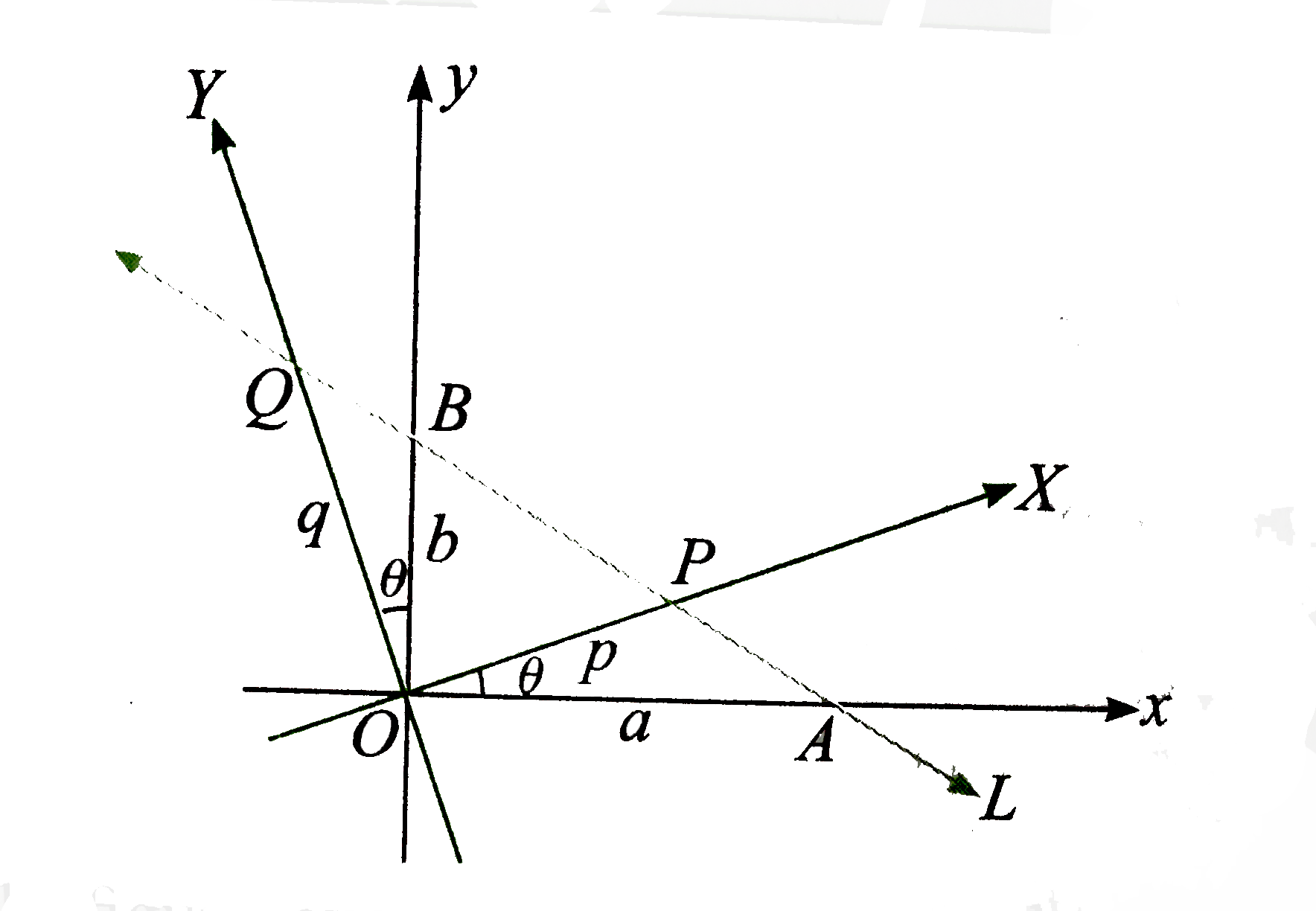Line L has intercepts aandb on the coordinate axes. When the axes are rotated through a given angle keeping the origin fixed, the same line L has intercepts pandq. Then a2+b2=p2+q2 1a2+1b2=1p2+1q2 a2+p2=b2+q2 (d) 1a2+1p2=1b2+1q2
(a) a2+b2=p2+q2
(b) 1a2+1b2=1p2+1q2
(c) a2+p2=b2+q2
(d) 1a2+1p2=1b2+1q2

As shown in the figure, axes are rotated by an angle θ about origin in anticlockwise direction.
Line L has intercepts a and b on original axes and intercepts p and q on rotated axes.
Equation of line L w.r.t. original axes is
xa+yb−1=0 (1)
Equation of line L w.r.t. rotated axes is
xp+yq−1=0 (2)
Since origin and line L are not changing their positions, distance of line from origin remains the same even though the axes are rotated.
So, comaring distances of lines given by equations (1) and (2) from origin, we get
∣∣0a+0b−1∣∣√1a2+1b2=∣∣0p+0q−1∣∣√1p2+1q2
⇒1a2+1b2=1p2+1q2
Topper's Solved these Questions
- BOOK - CENGAGE ENGLISHCHAPTER - STRAIGHT LINESEXERCISE - EXAMPLE12videos
STRAIGHT LINES
- BOOK - CENGAGE ENGLISHCHAPTER - STRAIGHT LINESEXERCISE - CONCEPT APPLICATION EXERCISE 2.123videos
STRAIGHT LINES
- BOOK - CENGAGE ENGLISHCHAPTER - STRAIGHT LINEEXERCISE - Multiple Correct Answers Type8videos
STRAIGHT LINE
- BOOK - CENGAGE ENGLISHCHAPTER - THEORY OF EQUATIONSEXERCISE - JEE ADVANCED (Numerical Value Type )1videos
THEORY OF EQUATIONS
Similar Questions
Line L has intercepts aandb on the coordinate axes. When the axes are rotated through a given angle keeping the origin fixed, the same line L has intercepts pandq. Then (a) a2+b2=p2+q2 (b)1a2+1b2=1p2+1q2 (c)a2+p2=b2+q2 (d) 1a2+1p2=1b2+1q2
View SolutionLine L has intercepts aandb on the coordinate axes. When the axes are rotated through a given angle keeping the origin fixed, the same line L has intercepts pandq. Then (a) a2+b2=p2+q2 (b)1a2+1b2=1p2+1q2 (c)a2+p2=b2+q2 (d) 1a2+1p2=1b2+1q2
View SolutionIf p is the length of perpendicular from the origin to the line whose intercepts on the axes are a and b, then show that 1p2=1a2+1b2.
View SolutionIf p is the length of perpendicular from the origin to the line whose intercepts on the axes are a and b, then show that 1p2=1a2+1b2 .
View SolutionIf p is the length of perpendicular from the origin to the line whose intercepts on the axes are a and b, then show that 1p2=1a2+1b2.
View SolutionIf p is the perpendicualr distance of the origin from the line whose intercepts on the axes are a and b, show that
1p2=1a2+1b2View SolutionIf p be the length of the perpendicular from the origin on the line x/a+y/b =1, then p2=a2+b2 b. p2=1a2+1b2 c. 1p2=1a2+1b2 d. none of these
View SolutionIf a plane has intercepts a, b and c on the coordinate axes and is at a distance of p units from the origin, prove that they 1a2+1b2+1c2=1p2
View SolutionProve that if a plane has the intercepts a, b, c and is at a distance of p units from the origin, then 1a2+1b2+1c2=1p2.
View SolutionGiven that tanα and tanβ,x2−px+q=0 , then value of sin2(α+β)= p2p2+(1−q)2 (b) p2p2+q2 q2p2+(1−q)2 (d) p2(p+q)2
View Solution

